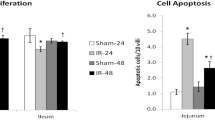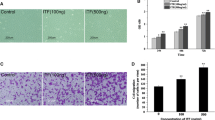Abstract
Epidermal growth factor (EGF) is an attractive and promising therapeutic application for intestinal disorders. The current study examined its influence on proliferation and restoration after ischemia–reperfusion (I/R) injury in rat small intestine. Six groups were performed: sham operation (Con); ischemia for 30 min with subsequent reperfusion for 30 min (I/R); I/R injured with 500 μg/kg EGF injected 5 min before ischemia (Pre-l); I/R injured with 50 μg/kg EGF injected 5 min before ischemia (Pre-s); I/R injured with 500 μg/kg EGF injected 5 min after reperfusion (Post-l); and I/R injured with 50 μg/kg EGF injected 5 min after reperfusion (Post-s). Intestinal histological damage, crypt cell proliferation degree, mucosal permeability, tight junction proteins expression, and levels of inflammation factors were studied for each group. Compared with the I/R group, administration of EGF in the Pre-l, Pre-s, and Post-l groups all presented a significant proliferation effect. The levels of FD4, IL-6, and TNF-α were dramatically decreased in all EGF-treated groups. Histological destruction was improved and TJs recovery was notably accelerated in all EGF-treated groups except the Post-s group. d-lactate concentration was only diminished in the Pre-l group. These results suggest that mucosally applied EGF can promote intestinal proliferation and improve restoration after I/R injury. EGF intraluminal administration is an effective treatment against intestinal I/R injury.






Similar content being viewed by others
References
Dominguez, J.A., and C.M. Coopersmith. 2010. Can we protect the gut in critical illness? The role of growth factors and other novel approaches. Critical Care Clinics 26: 549–565.
Carpenter, G., and S. Cohen. 1979. Epidermal growth factor. Annual Review of Biochemistry 48: 193–216.
Villa, X., J.W. Kuluz, C.L. Schleien, and J.F. Thompson. 2002. Epidermal growth factor reduces ischemia–reperfusion injury in rat small intestine. Critical Care Medicine 30: 1576–1580.
Berlanga, J., P. Prats, D. Remirez, et al. 2002. Prophylactic use of epidermal growth factor reduces ischemia/reperfusion intestinal damage. American Journal of Pathology 161: 373–379.
Geng, Y., J. Li, Q. Li, and L. Sun. 2012. Role of proliferation in the recovery of intestinal mucosal function after ischemia–reperfusion injury in rats. Parenteral and Enteral Nutrition 19: 288–292.
Chiu, C.J., A.H. McArdle, R. Brown, H.J. Scott, and F.N. Gurd. 1970. Intestinal mucosal lesion in low-flow states. I. A morphological, hemodynamic, and metabolic reappraisal. Archives of Surgery 101: 478–483.
Fujiyoshi, N., E. Feketeova, Q. Lu, D.Z. Xu, G. Hasko, and E.A. Deitch. 2006. Amiloride moderates increased gut permeability and diminishes mesenteric lymph-mediated priming of neutrophils in trauma/hemorrhagic shock. Surgery 140: 810–817.
Murray, M.J., M.D. Gonze, L.R. Nowak, and C.F. Cobb. 1994. Serum D(-)-lactate levels as an aid to diagnosing acute intestinal ischemia. American Journal of Surgery 167: 575–578.
Sun, X.Q., X.B. Fu, R. Zhang, et al. 2001. Relationship between plasma D(-)-lactate and intestinal damage after severe injuries in rats. World Journal of Gastroenterology 7: 555–558.
Grotz, M.R., E.A. Deitch, J. Ding, D. Xu, Q. Huang, and G. Regel. 1999. Intestinal cytokine response after gut ischemia: role of gut barrier failure. Annals of Surgery 229: 478–486.
Yang, R., X. Han, T. Uchiyama, et al. 2003. IL-6 is essential for development of gut barrier dysfunction after hemorrhagic shock and resuscitation in mice. American Journal of Physiology–Gastrointestinal and Liver Physiology 285: G621–G629.
Meng, Z.H., K. Dyer, T.R. Billiar, and D.J. Tweardy. 2001. Essential role for IL-6 in postresuscitation inflammation in hemorrhagic shock. American Journal of Physiology. Cell Physiology 280: C343–C351.
Inoue, K., M. Oyamada, S. Mitsufuji, T. Okanoue, and T. Takamatsu. 2006. Different changes in the expression of multiple kinds of tight-junction proteins during ischemia–reperfusion injury of the rat ileum. Acta Histochemica et Cytochemica 39: 35–45.
Feldman, G.J., J.M. Mullin, and M.P. Ryan. 2005. Occludin: structure, function and regulation. Advanced Drug Delivery Reviews 57: 883–917.
Fanning, A.S., B.J. Jameson, L.A. Jesaitis, and J.M. Anderson. 1998. The tight junction protein ZO-1 establishes a link between the transmembrane protein occludin and the actin cytoskeleton. Journal of Biological Chemistry 273: 29745–29753.
Dembinski, A., H. Gregory, S.J. Konturek, and M. Polanski. 1982. Trophic action of epidermal growth factor on the pancreas and gastroduodenal mucosa in rats. The Journal of Physiology 325: 35–42.
Ulshen, M.H., L.E. Lyn-Cook, and R.H. Raasch. 1986. Effects of intraluminal epidermal growth factor on mucosal proliferation in the small intestine of adult rats. Gastroenterology 91: 1134–1140.
Goodlad, R.A., T.J. Wilson, W. Lenton, H. Gregory, K.G. McCullagh, and N.A. Wright. 1987. Intravenous but not intragastric urogastrone-EGF is trophic to the intestine of parenterally fed rats. Gut 28: 573–582.
Scheving, L.A., R.A. Shiurba, T.D. Nguyen, and G.M. Gray. 1989. Epidermal growth factor receptor of the intestinal enterocyte. Localization to laterobasal but not brush border membrane. Journal of Biological Chemistry 264: 1735–1741.
Alison, M.R., and C.E. Sarraf. 1994. The role of growth factors in gastrointestinal cell proliferation. Cell Biology International 18: 1–10.
Miller, C.A., and H.T. Debas. 1995. Epidermal growth factor stimulates the restitution of rat gastric mucosa in vitro. Experimental Physiology 80: 1009–1018.
Clark, J.A., H. Gan, A.J. Samocha, A.C. Fox, T.G. Buchman, and C.M. Coopersmith. 2009. Enterocyte-specific epidermal growth factor prevents barrier dysfunction and improves mortality in murine peritonitis. American Journal of Physiology–Gastrointestinal and Liver Physiology 297: G471–G479.
Sullivan, P.B., P.J. Lewindon, C. Cheng, et al. 2007. Intestinal mucosa remodeling by recombinant human epidermal growth factor (1–48) in neonates with severe necrotizing enterocolitis. Journal of Pediatric Surgery 42: 462–469.
Palomino, A., F. Hernandez-Bernal, W. Haedo, et al. 2000. A multicenter, randomized, double-blind clinical trial examining the effect of oral human recombinant epidermal growth factor on the healing of duodenal ulcers. Scandinavian Journal of Gastroenterology 35: 1016–1022.
Sinha, A., J. Nightingale, K.P. West, J. Berlanga-Acosta, and R.J. Playford. 2003. Epidermal growth factor enemas with oral mesalamine for mild-to-moderate left-sided ulcerative colitis or proctitis. The New England Journal of Medicine 349: 350–357.
Sigalet, D.L., G.R. Martin, J.D. Butzner, A. Buret, and J.B. Meddings. 2005. A pilot study of the use of epidermal growth factor in pediatric short bowel syndrome. Journal of Pediatric Surgery 40: 763–768.
Clark, J.A., S.M. Doelle, M.D. Halpern, et al. 2006. Intestinal barrier failure during experimental necrotizing enterocolitis: protective effect of EGF treatment. American Journal of Physiology–Gastrointestinal and Liver Physiology 291: G938–G949.
Clark, J.A., R.H. Lane, N.K. Maclennan, et al. 2005. Epidermal growth factor reduces intestinal apoptosis in an experimental model of necrotizing enterocolitis. American Journal of Physiology–Gastrointestinal and Liver Physiology 288: G755–G762.
Halpern, M.D., J.A. Dominguez, K. Dvorakova, et al. 2003. Ileal cytokine dysregulation in experimental necrotizing enterocolitis is reduced by epidermal growth factor. Journal of Pediatric Gastroenterology and Nutrition 36: 126–133.
Berlanga-Acosta, J., J. Gavilondo-Cowley, P. Lopez-Saura, et al. 2009. Epidermal growth factor in clinical practice—a review of its biological actions, clinical indications and safety implications. International Wound Journal 6: 331–346.
Acknowledgments
This work was supported by the Key Project of National Natural Science Foundation in China (30830098), National Basic Research Program (973 Program) in China (no. 2009CB522405), National Natural Science Foundation in China (81070375), and Scientific Research Fund in Jiangsu Province (BK2009317).
Author information
Authors and Affiliations
Corresponding author
Rights and permissions
About this article
Cite this article
Geng, Y., Li, J., Wang, F. et al. Epidermal Growth Factor Promotes Proliferation and Improves Restoration After Intestinal Ischemia–Reperfusion Injury in Rats. Inflammation 36, 670–679 (2013). https://doi.org/10.1007/s10753-012-9591-x
Published:
Issue Date:
DOI: https://doi.org/10.1007/s10753-012-9591-x




